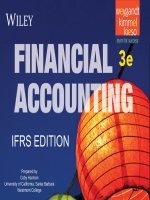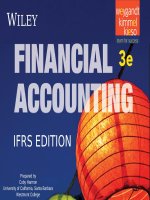Financial accounting 3e IFRS edtion willey chapter 13
Bạn đang xem bản rút gọn của tài liệu. Xem và tải ngay bản đầy đủ của tài liệu tại đây (8.19 MB, 85 trang )
WILEY
IFRS EDITION
Prepared by
Coby Harmon
University of California, Santa Barbara
Westmont
College
13-1
PREVIEW OF CHAPTER 13
Financial Accounting
IFRS 3rd Edition
Weygandt ● Kimmel ● Kieso
13-2
CHAPTER
13
Statement of Cash Flows
LEARNING OBJECTIVES
After studying this chapter, you should be able to:
13-3
1.
Indicate the usefulness of the statement of cash flows.
2.
Distinguish among operating, investing, and financing activities.
3.
Prepare a statement of cash flows using the indirect method.
4.
Analyze the statement of cash flows.
Statement of Cash Flows: Usefulness and Format
Learning Objective 1
Indicate the usefulness of the statement of
Provides information to help assess:
13-4
cash flows.
1.
Entity’s ability to generate future cash flows.
2.
Entity’s ability to pay dividends and meet obligations.
3.
Reasons for difference between net income and net cash provided (used) by operating activities.
4.
Cash investing and financing transactions during the period.
LO 1
Statement of Cash Flows
Question
Which of the following is incorrect about the statement of cash flows?
13-5
a.
It is a fourth basic financial statement.
b.
It provides information about cash receipts and cash payments of an entity during a period.
c.
It reconciles the ending Cash account balance to the balance per the bank statement.
d.
It provides information about the operating, investing, and financing activities of the business.
LO 1
Classification of Cash Flows
Learning Objective 2
Distinguish among operating, investing,
and financing activities.
Investing Activities
Financing Activities
Operating Activities
Income Statement Items
Changes in Investments
Changes in Non-current
and Non-current
Liabilities and Equity
Assets
13-6
LO 2
Classification of Cash Flows
Operating activities—Income statement items
Cash inflows:
Illustration 13-1
Typical receipt and payment classifications
From sale of goods or services.
From interest received and dividends received.
Cash outflows:
To suppliers for inventory.
To employees for wages.
To government for taxes.
To lenders for interest.
To others for expenses.
13-7
LO 2
Classification of Cash Flows
Investing activities—Changes in investments and non-current assets
Cash inflows:
Illustration 13-1
Typical receipt and payment classifications
From sale of property, plant, and equipment.
From sale of investments in debt or equity securities of other entities.
From collection of principal on loans to other entities.
Cash outflows:
To purchase property, plant, and equipment.
To purchase investments in debt or equity securities of other entities.
To make loans to other entities.
13-8
LO 2
Classification of Cash Flows
Financing activities—Changes in non-current liabilities and equity
Cash inflows:
Illustration 13-1
Typical receipt and payment classifications
From sale of ordinary shares.
From issuance of long-debt (bonds and notes).
Cash outflows:
To shareholders as dividends.
To redeem long-term debt or reacquire
ordinary shares (treasury shares).
13-9
LO 2
Significant Non-Cash Activities
1.
Direct issuance of ordinary shares to purchase assets.
2.
Conversion of bonds into ordinary shares.
3.
Issuance of debt to purchase assets.
4.
Exchanges of plant assets.
Companies report non-cash activities in either a
13-10
separate schedule (bottom of the statement) or
separate note to the financial statements.
LO 2
Accounting Across the Organization
Net What?
Net income is not the same as net cash provided by operating activities. Below are some results from recent annual
reports (currencies in millions). Note the wide disparity among these companies, all of which engage in retail
merchandising.
13-11
LO 2
Format of the Statement of Cash Flows
Order of Presentation:
Direct Method
1.
13-12
Operating activities.
Indirect Method
2.
Investing activities.
3.
Financing activities.
LO 2
Illustration 13-3
Format of statement of cash flows
13-13
LO 2
>
DO IT!
Illustration: Classify each of these transactions by type of cash flow activity.
1.
Issued 100,000 HK$50 par value ordinary shares for HK$8,000,000 cash.
2.
Borrowed HK$2,000,000 from Castle Bank, signing a 5-year note bearing 8%
interest.
3.
Purchased two semi-trailer trucks for HK$1,700,000 cash.
4.
Paid employees HK$120,000 for salaries and wages.
5.
Collected HK$200,000 cash for services performed.
Financing
Financing
Investing
Operating
Operating
13-14
LO 2
Preparing the Statement of Cash Flows
Three sources of information:
13-15
1.
Comparative statements of financial position
2.
Current income statement
3.
Additional information
LO 2
Preparing the Statement of Cash Flows
Three Major Steps:
Illustration 13-4
Three major steps in preparing
the statement of cash flows
13-16
LO 2
Preparing the Statement of Cash Flows
Three Major Steps:
Illustration 13-4
Three major steps in preparing
the statement of cash flows
13-17
LO 2
Preparing the Statement of Cash Flows
Three Major Steps:
Illustration 13-4
Three major steps in preparing
the statement of cash flows
13-18
LO 2
Indirect And Direct Methods
Companies favor the indirect method for two reasons:
13-19
1.
Easier and less costly to prepare.
2.
Focuses on differences between net income and net cash flow from operating activities.
LO 2
Preparing the Statement of Cash Flows
Question
The statement of cash flows classifies cash receipts and cash payments by these activities:
13-20
a.
operating and non-operating.
b.
investing, financing, and operating.
c.
financing, operating, and non-operating.
d.
investing, financing, and non-operating.
LO 2
Learning Objective 3
Statement of Cash Flows:
Prepare a statement of cash flows using the
indirect method.
—Indirect Method
Illustration 13-5
Comparative statements of financial position, income statement, and additional information for Computer Services
13-21
Company
LO 3
Illustration 13-5
Comparative statements of financial position, income statement, and additional information for Computer Services
Company
13-22
LO 3
Change in
2017
2016
Account Balance
Illustration 13-5
Additional information for 2017:
1.
2.
3.
4.
5.
6.
13-23
Depreciation expense was comprised of €6,000 for building and €3,000 for equipment.
The company sold equipment with a book value of €7,000 (cost €8,000, less accumulated depreciation €1,000) for €4,000 cash.
Issued €110,000 of long-term bonds in direct exchange for land.
A building costing €120,000 was purchased for cash. Equipment costing €25,000 was also purchased for cash.
Issued ordinary shares for €20,000 cash.
The company declared and paid a €29,000 cash dividend.
LO 3
Step 1: Operating Activities
DETERMINE NET CASH PROVIDED/USED BY OPERATING ACTIVITIES BY
CONVERTING NET INCOME FROM ACCRUAL BASIS TO CASH BASIS.
Common adjustments to Net Income (Loss):
13-24
Add back non-cash expenses (depreciation, amortization, or depletion expense).
Deduct gains and add losses.
Analyze changes to non-cash current asset and current liability accounts.
LO 3
Step 1: Operating Activities
Question
Which is an example of a cash flow from an operating activity?
13-25
a.
Payment of cash to lenders for interest.
b.
Receipt of cash from the issuance of ordinary shares.
c.
Payment of cash dividends to the company’s shareholders.
d.
None of the above.
LO 3









